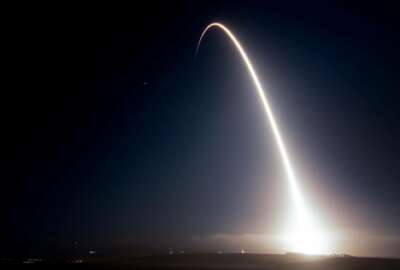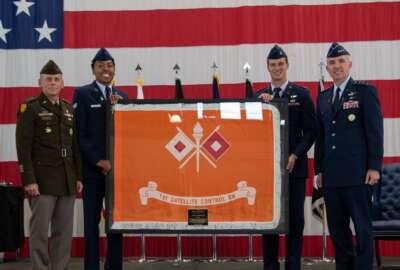
Space Force finds multiple paths to training its guardians
As space fills its ranks with cyber and satellite specialists, it has to build out its training abilities.
As the Space Force continues to build its capabilities, it has to figure out how to train the growing number of guardians coming into its ranks. For now the solution remains a cobbled-together system of using its own training command and supplementing that with resources from the Air Force and the private sector.
The technology-heavy new service relies on skilled operators to run and maintain its arsenal of satellites and sensors that make up U.S. presence in space. While the Space Force maintains Space Training and Readiness Command (STARCOM) as its central training command for guardians, it must farm out a variety of skills training to other sources in order to quickly train its recruits.
“ Our work is highly technical and our chief of space operations envisions the ability to provide advanced degrees to guardians who want to pursue them,” said Lisa Costa, the Space Force’s chief technology and innovation officer told attendees at [Armed Forces Communications & Electronics Association (AFCEA’s)] Northern Virginia’ Space Force IT Day Tuesday.
Costa said there is no university where you can go to get a space degree, but the service actively looks for recruits and future officers who have an aptitude in space warfare who can then get training in a variety of different university and non-academic settings.
“We’re drawing in and creating a pipeline for the Space Force. We do not have our own ROTC program. So we use the Department of the Air Force ROTC program, and we bring folks in through that as an accession program. But we want to make sure that we are differentiating Space Force to students as they’re going through the pipeline so that we can draw in recruits with extremely diverse, cognitively diverse backgrounds into the service,” Costa said.
Much of the service’s cyber training is done at The 39th Information Operations Squadron (IOS), located at Hurlburt Field in Florida. The Air Force’s information, operations and cyber training unit trains and qualifies cyber operators for both the Air Force and the Space Force.
“We’re partnering with the Air Force and the 39th IOS in terms of the training that we’re providing, and the level of capability that we’re giving our guardians to really be able to do a large portion of what a cyber protection team would do, but to have them be on station knowing and understanding and developing that key terrain in such a way that they’re able to defend it against a peer adversary,” said Col. Joseph Wingo, the Space Force’s chief of cyber and spectrum operations.
Wingo said in both the enlisted and officer ranks, many guardians come into the service with an extensive background in IT, whether through private sector jobs, academic degrees, or experience in other services. Even with that background, the skill set needed for the Space Force requires a pivot in training and knowledge base.
“Training takes a long time to do and one of the things that we’re doing is leveraging some of the existing Air Force training structures. But that’s not enough. And so we’re constantly looking for ways that we can partner with industry,” Wingo said. “How do we train up our guardians who are going to be cyber defenders? How do we get them from IT, where they’ve been? Because we’re going to have this spike of guardians coming through who are transitioning from IT over to cyber defense.”
Copyright © 2024 Federal News Network. All rights reserved. This website is not intended for users located within the European Economic Area.
Alexandra Lohr, a former staff member, covered the Defense Department for Federal News Network until September 2023.





